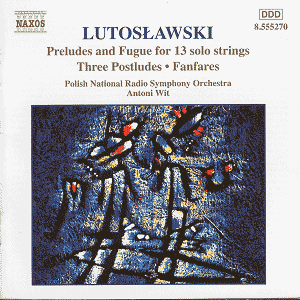Lutoslawski was one of the most important composers
of the second half of the 20th century. His early works were relatively
conservative in style, often making use of folk material. However, following
the inauguration, in 1956, of the Warsaw Autumn Festival, one of the
world's leading festivals of contemporary music, he embarked upon a
new phase in his artistic development, since Poland was now making renewed
contact with the prominent forces of the musical life of the West.
Lutoslawski gained an international reputation, as
a distinctly modernist voice with a clearly individual personality.
For more than thirty years from that time, he produced a succession
of masterpieces for the world's leading soloists and orchestras.
This disc is Volume 7 in Naxos's continuing series
of the complete orchestral music, which is itself a reflection of the
composer's achievement. Antoni Wit and his talented orchestra (or, to
be more accurate, the ensembles drawn from the orchestra) give good
accounts of this challenging and rewarding music. The opening group,
the Three Postludes, makes a particularly compelling impression,
with real impact from the recording, despite the gap between the recording
sessions. The orchestral textures and combinations are particularly
interesting, and the three pieces have both individuality and a convincing
sweep of inspiration. At this price the disc is worth investigating
for these pieces alone.
The best known music recorded here is the Preludes
and Fugues for 13 solo strings. Again the inspiration is of the
highest order, the performance thoroughly idiomatic. A typical feature
of this music is Lutoslawski's employment of 'chance elements' under
the control of the wider context of the piece; therefore no two performances
will be quite the same. The excellent booklet notes by Richard Whitehouse
point out that this is the longest of the composer's mature compositions,
but it is of course made up of smaller constituent parts which operate
together.
The disc is completed by a sequence of shorter pieces,
some of them very short indeed. For example, the Fanfare for CUBE
first performed by the Philip Jones Brass Ensemble at the 1982 Lucerne
Festival in 1982, plays for 28 seconds. But it is still an imaginatively
contrived piece, the work of a major composer.
Lutoslawski is well served here. These performances
all contribute to a highly successful combination, in thoroughly acceptable
sound , with talented musicians performing under a gifted conductor.
Terry Barfoot


